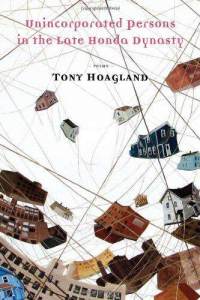
In his fourth full-length book of poems, Unincorporated Persons in the Late Honda Dynasty, Tony Hoagland shows us that poetry can and will accommodate the 21st century American human condition, in all its aging, democratic, consumer culture glory. His discerning eye finds the touching beauty of scenes as familiar as red lights illuminating “shopped-out middle-aged faces” after a fender bender in a mega-mall parking lot, and as varied as SWAT Teams and camera crews stationed on a DC rooftop, on the look-out for a recently infamous sniper.
Perhaps the book’s greatest strength is how well it captures the American experience. His tone is often that of the reserved, detached social commentator, but occasionally we see a show of concern, empathy, and consciousness of his ties to the world observed. In fact, his aloofness is testament to his empathy, and purposeful: our era provides more opportunities than ever before to view each other’s humanity with an onlooker’s distance. Interestingly, in Hoagland’s collection of essays on poetry and craft, Real Sofistikashun, he notes that successful contemporary poets recognize that “stories of the self… are an exhausted resource.” Thus, his poems highlight our culture’s inundation with information and mass-produced objects, and play with the resultant apathy toward certain kinds of knowledge and experience.
Although he is occasionally personal, he mostly writes with the aloof authority of someone who’s laid equally attentive eyes on the Alabama woods, the carpeted hall of an expensive hotel, the demolition site, The Galleria in Texas, “the midnight Starbucks Golgotha,” the interstate and the alleyway. His descriptions arc from corner to corner of the contemporary American environment, and at times, Hoagland risks alienating potential readers by seeming too arrogantly removed from the narratives he surveys. When dealing with aging and the loss of virility, for instance, his tone is more humorous and condescending than mournful and sympathetic. His attempts to seem sincere and sensitive are usually confined to a stanza in the last third of his poems. Because of their brevity, these tonal shifts seem superficial. For example, in “Hard Rain,” Hoagland inserts a Dear Abby letter from America, concerned about her traveling businessman father who always returns bearing great gifts but also blood-stained shoes and trousers. The speaker reacts:
I used to think I was not part of this,
that I could mind my own business and get along,
but that was just another song
that had been taught to me since birth-
whose words I was humming under my breath
as I was walking through the Springdale Mall.
Assigning such levity about our nation’s record of disregard for international sovereignty and human life to a young girl seems, to a part of me, like a distasteful gesture. However, I ultimately accept that such moments are included as part of a larger project of enunciating something about the American experience.
One of those somethings is the way Hoagland identifies the human compulsion to investigate difficult topics further, which often leads to confusion and regret, as the sometimes cursed gift that it is. This is compellingly accomplished in “Hinge,” a poem about DNA testing and race. Americans thus require distraction, by any means possible. In poems like “Complicit with Everything,” Hoagland reminds us that probing into all topics broadcast on TV evokes in some a need to appreciate the prettiness of (suburban) nature, like the weed sprouting under the air conditioner drip, “looping around and around, and leafing out, / like bright green embroidery against white siding.”
The poems’ shapes – usually left-justified and mostly symmetrical in stanza length – also help remind us of the aesthetic needs and preferences of our first world culture. By not adhering to formal techniques but still presenting a degree of symmetry and uniformity, he creates a context where we can stomach the semantic barrage of commodities and social critique. So much variety, when neatly packaged and stacked and separated, like people in skyscrapers and products in grocery aisles, appeals to our eyes by providing a sense of order and harmony.
Yet one more tool in our culture’s distraction toolbox is late night comedy style humor, and Hoagland does not fail to direct our attention to the absurdity and humor of human sexuality. For example, he wonders about the similarities between mating rituals of adults at the park and insects and animals featured on the nature channel, and whether “persons in the Midwest… can kiss without debating the imperialist baggage of heterosexuality.” Similarly, his account of his parenting Green Beret style functions both as comic relief and as one of a few snippets that provide us with a sense of Hoagland’s ethos.
This review is not meant to replace a reading of the book, because his skillful, metaphoric ornamentation of contemporary observations with a shared public meaning is admirable. Despite moments when his voice borders on arrogant (after all, this is a book by, for, and about the American), the collection as a whole maintains an understated poignancy in its honest attempts to locate something resembling an uplifted, surviving human spirit. With two poems to go, Hoagland invites us to become unincorporated, at the top of a snow globe, and to draw from “hope, like a pocket of air.” If I ever dislike the book, it is because I dislike the Dynasty it depicts. And if this is the latter part of the Dynasty, as the title suggests, it leaves me wondering: Where to next?

